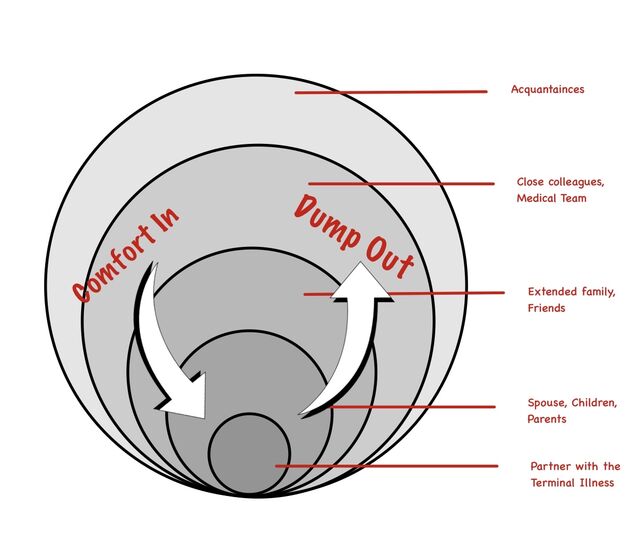Grief
Using Ring Theory Paradigm When Dealing With a Terminal Illness
An exploration into the benefits and limitations of Ring Theory.
Posted August 18, 2022 Reviewed by Michelle Quirk
Key points
- In Ring Theory, the ill partner becomes the priority, and the other partner cannot reveal their angst and grief to them.
- Ring Theory may benefit the person earlier in the illness, but other approaches should be considered for the longer term.
- The most important tool in a relationship is a couple's ability to communicate. No single paradigm can take its place.

When one partner is diagnosed with a terminal illness, there is a great need for the significant other to find a way to “be there” for their loved one, but the details of what “being there” really means elude some couples.
The partner with the illness has his/her own angst to deal with, and you have your own trauma in response to his. Some typical existential issues that surface include these: How am I going to possibly deal with the death of my partner? How much time does he/she have? How will this affect our kids? How can I keep this family going without him/her? How can I live on my own, psychologically and financially?
The partner confronting his own mortality presents one aspect of the ordeal, but, regardless of how large a shadow is cast on the person on the receiving end, it equals to or even pales in comparison to its felt presence on the entire family dynamic/the intimate relationship we have with our family and especially our partner. Exposure to a terminal illness steers the relationship to great uncertainty. For some who have experienced a loss of an intimate person in their life, this may trigger a previous trauma that hasn’t been fully processed. For others, the prior experience of the crucible of death has provided the necessary wisdom and comfort needed to cope better during this time of trouble.
What Is the Ring Theory Paradigm?
One way a couple can deal with this dynamic is to adopt a Ring Theory paradigm in their approach. The premise is that the partner with the terminal illness becomes the priority. Essentially, all the attention is focused on them. The relationship adjusts itself to take that into account. Understandably, the partner who has been diagnosed with a terminal illness has been dealt the worst possible hand with a life-limiting illness and is in need of the most care and attention. From the time of the diagnosis, whatever the person requires to help them process, adjust, and cope is all based on their needs.

The theory asks you to imagine concentric rings around the innermost central ring that represents the partner with the diagnosis. The closest orbiting ring is the significant other. Outside that is the person(s) farther removed in the relationship. A likely scenario of outside rings could contain extended family, close friends, caregivers, work relationships, online or support groups, and the health care team. The central tenet is that only comfort and support go in from the outside rings to the inner rings at all times. All felt angst/psychological distress is expelled or “dumped” out from the inner to the outer rings.
Practically, what this means is that the ill person’s partner cannot reveal their burden of suffering to the partner who has the terminal illness. They cannot process with their partner and must manage their angst and grief on their own with the aid of circles outside theirs. They should not enmesh themselves or “steal the spotlight” from the partner with the terminal illness for they already have far too much to bear and will be harmed by the partner’s grief.
A friend of mine, whose husband was diagnosed with metastatic cancer, expressed the predicament this way:
The idea that I have to secure my own oxygen mask before my partners is bullsh*t! My job is to secure his mask before my own. It’s not just about me or my self-care. The greatest thing I can do or will ever do is to take care of my husband.
My strength comes from my social support. I direct my worst fears and anxiety to them. I only direct supportive energy to my partner. The person at the center gets to do whatever. My moments of real crying are not for him. Every time I speak about my fears and worries [to the person(s) in the outer rings], every time I say it over and over again, the fear, worry, and tragedy get diffused a little bit. It gets a little bit easier to manage and get perspective.
Ring Theory provides an instrumental approach to navigating an immensely difficult time in a relationship, especially at the outset when the ill partner needs time to process the meaning behind the diagnosis and to allow himself to take the time to come to terms with his new reality.
Undoubtedly, the focus on the ill partner is especially appropriate in the early stages of illness and during the time needed to engage with and process the emotional trauma and shock of the diagnosis—there is little chance that they would want to or be able to cope with anything but their own situation. A “comfort in approach” would seem to be the optimal strategy. However, moving forward, when one has had time to take in the news and get their bearings back, the long-term application of Ring Theory needs to be applied with nuance and discernment.
Nuanced Application of Ring Theory
If taken concretely, it emphasizes and focuses on the ill individual and takes away their ability or need to be of service to their partner, or on bearing witness and offering solace to others who are in need. Understanding that the ill partner has to handle their own existential distress and grief, we cannot assume that every individual needs to be so protected so as to not want to be near the burden of another’s grief and distress.
Of course, there are times that surely such suffering is too much to bear, and comfort is the only thing that is needed. We all have our limits of what we can handle at any one time. The problem with overgeneralization or in providing such advice, however, is that it over-indexes the individualism and offers a paternalistic and perhaps an infantilizing approach to a partner who is ready to share in and perhaps needs to share in the angst and tragedy that has befallen his partner and in so doing strengthen the relationship by offering opportunities for greater intimacy.
When we are young and immature, we lack the ability to self-soothe and require our caregivers to nurture us for psychological safety. As we get older and mature, most of us develop the skill of self-nurturing and in its more developed form, we develop the want and in some cases the need to provide for nurturing of others, especially of those who are closest to us. It is a need that is in service not only to the other but also to oneself. And, in that regard, providing for the other is also providing for ourselves. Constantly focusing on the ill person and not allowing them to share in the burden of their partner robs them of their meaning, power, and growth.
Take, for example, a woman suffering from advanced breast cancer who has two young kids and a husband and, despite the terminal nature of her disease, still works at her law firm. At the same time, she is also dealing with the imminent death of her ailing father and has made it a priority to travel out of state to be with him during his last days. Ring Theory would advocate for self-centeredness with the focus being on her as she is the one with the terminal illness. However, life is much more complex than that, and for her, it was meaningful and of extreme value to be with her ill father and provide for his needs as he passes. For her, giving to another in her family was more important than being of focus only on herself. By being present for her father, she found meaning and consolation that was worth more to her than the spotlight only on herself.
As written in a previous post by Laura Otis, Ph.D., A Critique of Ring Theory,
Some afflicted people, in some moments, may need comfort above all; others may be hungry to hear about troubles other than their own. They may want to feel more connected to the world and giving as well as receiving comfort may make them feel more valued. Certainly, one shouldn’t force one’s troubles on a suffering person, but if deep knowledge of that person’s personality and moods indicates that they want to hear them, one has a right to share.




